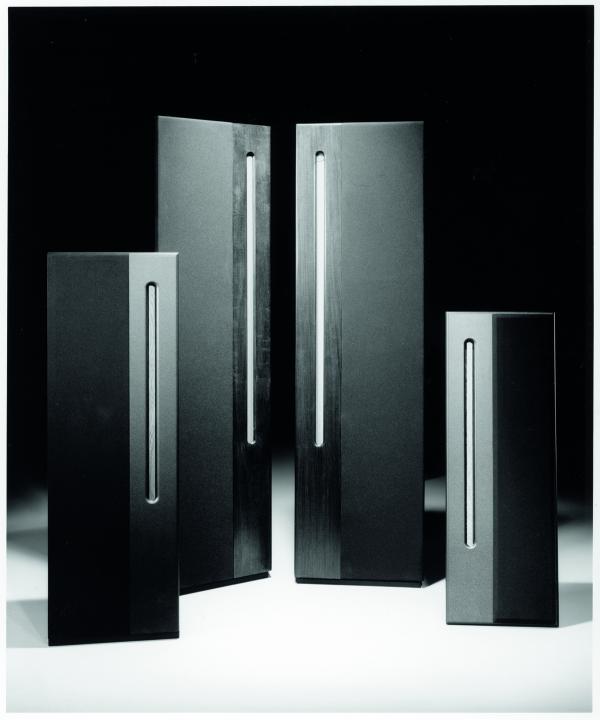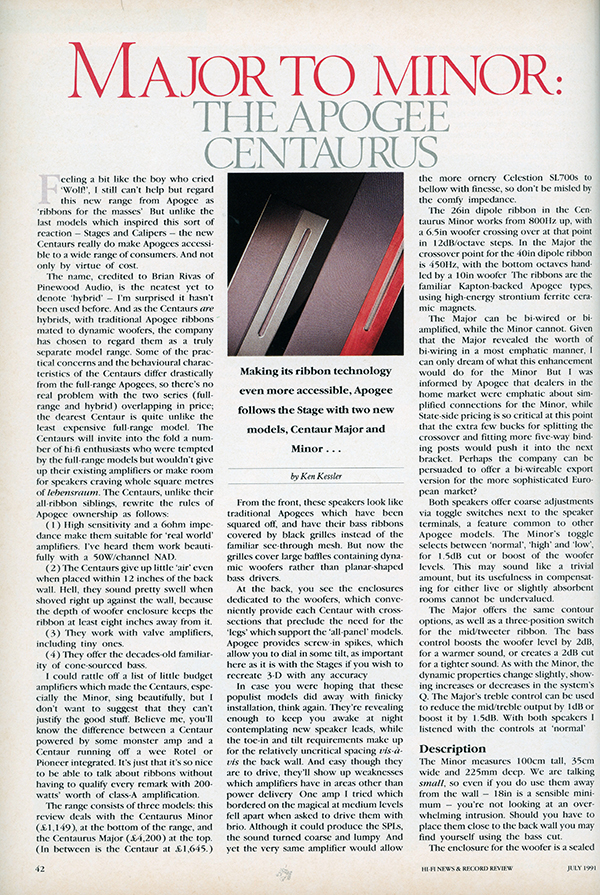Major to Minor Page 2

Contour Options
The 26in dipole ribbon in the Minor works from 800Hz up, with a 6.5in woofer crossing over at that point in 12dB/octave steps. When it comes to the Major the crossover point for the 40in dipole ribbon is 450Hz, with the bottom octaves handled by a 10in woofer. The ribbons are the familiar Kapton-backed Apogee types, using high-energy strontium ferrite ceramic magnets.
The Major can be bi-wired or bi-amped, while the Minor cannot. Given that the Major revealed the worth of bi-wiring in a most emphatic manner, I can only dream of what this enhancement would do for the Minor. But I was informed by Apogee that dealers in the home market were emphatic about simplified connections for the Minor, while Stateside pricing is so critical at this point that the extra few bucks it would cost for splitting the crossover and fitting more five-way binding posts would push it into the next bracket.
Both speakers offer coarse adjustments via toggle switches next to the speaker terminals. The Minor’s toggle selects between ‘normal’, ‘high’ and ‘low’, for 1.5dB cut or boost of the woofer levels. This may sound like a trivial amount, but its usefulness in compensating for either live or slightly absorbent rooms cannot be undervalued.
The Major offers the same contour options, as well as a three-position switch for the mid/tweeter ribbon. The bass control boosts the woofer level by 2dB, for a warmer sound, or creates a 2dB cut for a tighter sound. As with the Minor, the dynamic properties change slightly, showing increases or decreases in the system’s Q. The Major’s treble control can be used to reduce the mid/treble output by 1dB or boost it by 1.5dB. I listened to both speakers with the controls at ‘normal’.

Cut ’n’ Cover
The Minor measures 100cm tall, 35cm wide and 22.5cm deep. We are talking small, so even if you do use them away from the wall – 18in is a sensible minimum – you’re not looking at an overwhelming intrusion. Should you have to place them close to the back wall you may find yourself using the bass cut.
The enclosure for the woofer is a sealed cabinet measuring 710x200x180mm (hwd), and it’s not seen when you view the speaker from the front. The grilles are permanently fixed so all I can tell you about the 6.5in woofer is that it features a 1in voice coil and its cone is made of mineral-filled polypropylene, with a synthetic rubber surround. The Minor is finished in a dark grey paint which is not unlike ‘Hammerite’.
While Apogee doesn’t state the sensitivity, the Minor is a 6ohm (nominal) load, with a 4ohm minimum. A 50W/channel amplifier is recommended as the minimum, with 100W/ch maximum. And Apogee says that the Minor will deliver 107dB peaks at 4m using a 50W amplifier. In hands-on terms, I drove this to what I consider uncomfortable levels – 98dB at 1.5m – with a 35W/ch valve amp without detecting a trace of clipping from the amp or rasp from the speakers. And that’s in a room with low ambient noise levels, so I’m talking loud. Frequency response, by the way, is stated as 40Hz-20kHz.
Weight Gain
The Major is another story entirely. In addition to an extra nine cycles down below, it seems more sensitive despite a minimum recommendation of 80W per channel (200W max). But it’s a change in the sonic character in terms of greater weight at all levels rather than easier ‘driveability’ which creates this impression.
The Major is not for the space shy. Standing 163cm tall, with a 46cm wide frontal aspect and total depth of 30cm, the speaker is only slightly less imposing than a Duetta or a Diva. The standard finish is the same anthracite colour as that of the Minor, but the review pair arrived with the optional rosewood veneer and looked positively gorgeous.
Feeling Flush
As with the Minor, the woofer enclosure is not visible from the front. It measures 107cm tall, but – instead of a square cross section as in the Minor – it’s 28cm deep, with a frontal width of 27cm and a back panel width of 20cm. In both cases, the woofer enclosures are rock solid and internally braced, while the shape of the Major’s cabinet is intended to further reduce the effect of internal standing waves.
The Major, too, works best with a minimum of 18in clearance from the back wall, but you can just about get away with flush placement. With both speakers, fine-tuning involves the usual Apogee four-step, juggling tilt (using the screw-in spikes), toe-in, fore-and-aft placement and left/right positioning. What’s important for those who might consider the Minor due to its suitability for small rooms is the optional stand, which adds a few inches to the height but adjusts the tilt for nearfield listening.
My main concern with these speakers involved the amplifier selection. Using the familiar battery of sources – Lyra Clavis cartridge, SME V/Oracle front end, and CAL and Marantz CD-12 CD players – I spent most of my time swapping amplifiers, trying hard to find one which wouldn’t drive the Centaurs. Let me tell you something else: nobody has heard what an Apogee can do unless they’ve used valves. And, as we all know, this has been denied us due to the hideously low impedances of the full-range models. A Croft Series 5, Radford STA-25, a 35W/channel from Woodside costing roughly the same as a pair of Minors and some 100W monoblocks from Ray Lumley, drove the Minor to adequate levels – and the Major.


















































